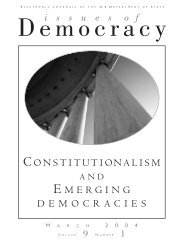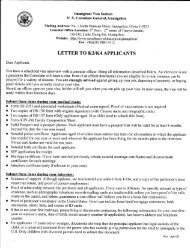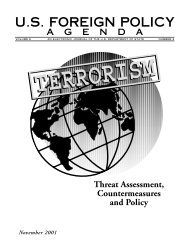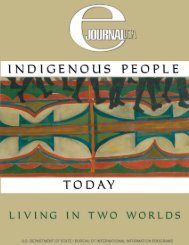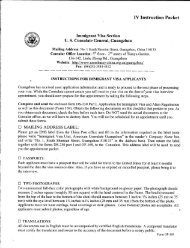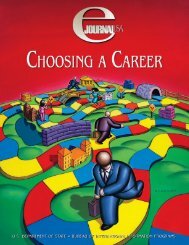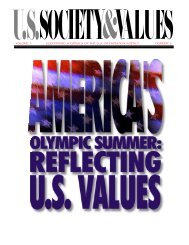s. history us history us history - Embassy of the United States
s. history us history us history - Embassy of the United States
s. history us history us history - Embassy of the United States
- No tags were found...
Create successful ePaper yourself
Turn your PDF publications into a flip-book with our unique Google optimized e-Paper software.
CHAPTER 4: THE FORMATION OF A NATIONAL GOVERNMENTOUTLINE OF U.S. HISTORYhad been signed, <strong>the</strong> two sides continuedfighting into 1815 near NewOrleans, Louisiana. Led by GeneralAndrew Jackson, <strong>the</strong> <strong>United</strong> <strong>States</strong>scored <strong>the</strong> greatest land victory <strong>of</strong><strong>the</strong> war, ending for once and for allany British hopes <strong>of</strong> reestablishingcontinental influence south <strong>of</strong> <strong>the</strong>Canadian border.While <strong>the</strong> British and Americanswere negotiating a settlement,Federalist delegates selected by <strong>the</strong>legislatures <strong>of</strong> Massach<strong>us</strong>etts, RhodeIsland, Connecticut, Vermont, andNew Hampshire ga<strong>the</strong>red in Hartford,Connecticut, to express oppositionto “Mr. Madison’s war.” NewEngland had managed to trade with<strong>the</strong> enemy throughout <strong>the</strong> conflict,and some areas actually prosperedfrom this commerce. Never<strong>the</strong>less,<strong>the</strong> Federalists claimed that <strong>the</strong> warwas ruining <strong>the</strong> economy. With apossibility <strong>of</strong> secession from <strong>the</strong>Union in <strong>the</strong> background, <strong>the</strong> conventionproposed a series <strong>of</strong> constitutionalamendments that wouldprotect New England interests. Instead,<strong>the</strong> end <strong>of</strong> <strong>the</strong> war, punctuatedby <strong>the</strong> smashing victory at New Orleans,stamped <strong>the</strong> Federalists with astigma <strong>of</strong> disloyalty from which <strong>the</strong>ynever recovered. 9THE SECOND GREAT AWAKENINGBy <strong>the</strong> end <strong>of</strong> <strong>the</strong> 18th century, many educated Americans no longerpr<strong>of</strong>essed traditional Christian beliefs. In reaction to <strong>the</strong> secularism <strong>of</strong> <strong>the</strong> age,a religio<strong>us</strong> revival spread westward in <strong>the</strong> first half <strong>of</strong> <strong>the</strong> 19th century.This “Second Great Awakening” consisted <strong>of</strong> several kinds <strong>of</strong> activity,distinguished by locale and expression <strong>of</strong> religio<strong>us</strong> commitment. In NewEngland, <strong>the</strong> renewed interest in religion inspired a wave <strong>of</strong> social activism.In western New York, <strong>the</strong> spirit <strong>of</strong> revival encouraged <strong>the</strong> emergence <strong>of</strong> newdenominations. In <strong>the</strong> Appalachian region <strong>of</strong> Kentucky and Tennessee, <strong>the</strong>revival streng<strong>the</strong>ned <strong>the</strong> Methodists and <strong>the</strong> Baptists, and spawned a new form<strong>of</strong> religio<strong>us</strong> expression — <strong>the</strong> camp meeting.In contrast to <strong>the</strong> Great Awakening <strong>of</strong> <strong>the</strong> 1730s, <strong>the</strong> revivals in <strong>the</strong>East were notable for <strong>the</strong> absence <strong>of</strong> hysteria and open emotion. Ra<strong>the</strong>r,unbelievers were awed by <strong>the</strong> “respectful silence” <strong>of</strong> those bearing witnessto <strong>the</strong>ir faith. The evangelical enth<strong>us</strong>iasm in New England gave rise tointerdenominational missionary societies, formed to evangelize <strong>the</strong> West.Members <strong>of</strong> <strong>the</strong>se societies not only acted as apostles for <strong>the</strong> faith, but aseducators, civic leaders, and exponents <strong>of</strong> Eastern, urban culture. Publicationand education societies promoted Christian education. Most notable among<strong>the</strong>m was <strong>the</strong> American Bible Society, founded in 1816. Social activisminspired by <strong>the</strong> revival gave rise to abolition <strong>of</strong> slavery groups and <strong>the</strong> Societyfor <strong>the</strong> Promotion <strong>of</strong> Temperance, as well as to efforts to reform prisons andcare for <strong>the</strong> handicapped and mentally ill.Western New York, from Lake Ontario to <strong>the</strong> Adirondack Mountains, hadbeen <strong>the</strong> scene <strong>of</strong> so many religio<strong>us</strong> revivals in <strong>the</strong> past that it was known as<strong>the</strong> “Burned-Over District.” Here, <strong>the</strong> dominant figure was Charles GrandisonFinney, a lawyer who had experienced a religio<strong>us</strong> epiphany and set out topreach <strong>the</strong> Gospel. His revivals were characterized by careful planning,showmanship, and advertising. Finney preached in <strong>the</strong> Burned-Over Districtthroughout <strong>the</strong> 1820s and <strong>the</strong> early 1830s, before moving to Ohio in 1835to take a chair in <strong>the</strong>ology at Oberlin College, <strong>of</strong> which he subsequentlybecame president.Two o<strong>the</strong>r important religio<strong>us</strong> denominations in America — <strong>the</strong> Mormonsand <strong>the</strong> Seventh Day Adventists — also got <strong>the</strong>ir start in <strong>the</strong> Burned-Over District.8687



